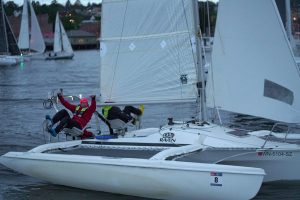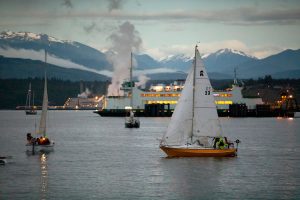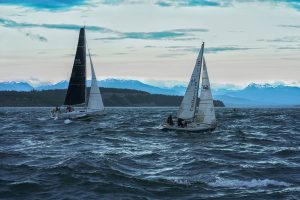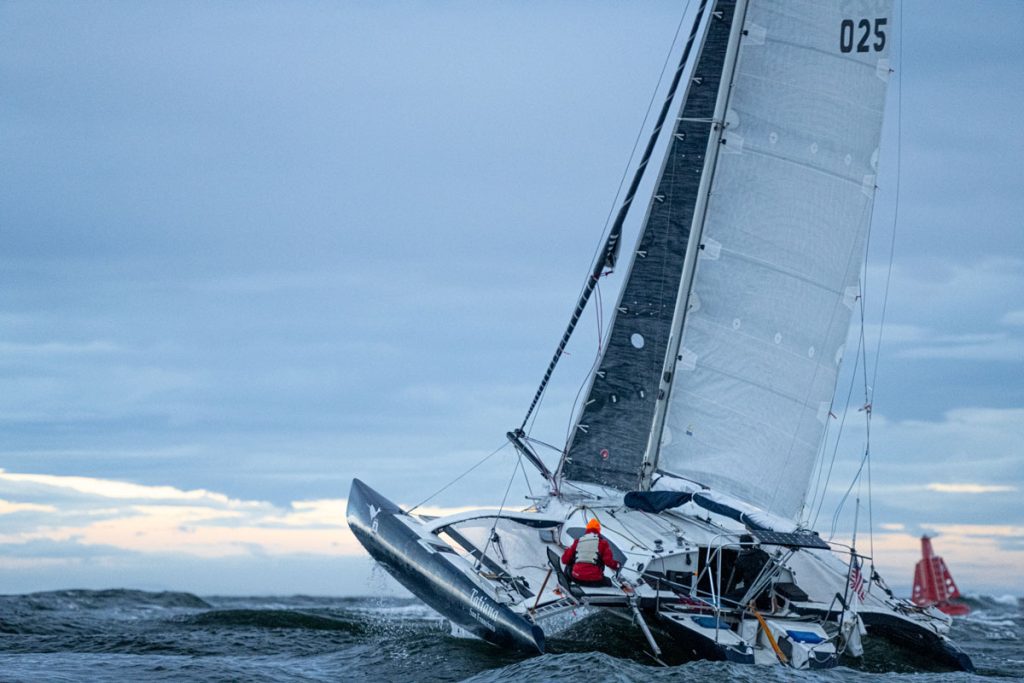Field Report
photo: Team Narwhal by Jim Meyers
First, most important: everyone is ok. Us, you, 100% of this year’s racers, and the brave men and women of the US Coast Guard and R2AK support vessels that affected four rescues in the Race’s first four hours. Everyone is ok.
Bruised egos, dashed dreams, but body and souls intact. Breathe in, exhale slowly. Everyone is ok.
Level set/spoiler complete, the first 24 hours of this Race to Alaska started 12 hours before the starting gun. Yes, people showed up in the hundreds to cheer the teams across the starting line to the rousing chorus of the Ukrainian National Anthem. It was calm, community-spirited, and topically resonant. It felt great to be rousing again after almost three years of paranoid shrinking.
But before that, while the party still raged and free R2AK tattoos were still being needled into forearms, Race HQ extended the time window for racers to get to Victoria by a full 24 hours. Don’t be dumb, get there by Wednesday night, we told them. Why? The triple threat of wind, tide, and the knee knocker that is the Strait of Juan de Fuca.
If R2AK is a hero’s journey, Stage One is the impartial arch villain. Voldemort, the eye of Sauron, one Darth or another; from the 40-ish rough water miles between the Port Townsend starting line and the welcome embrace of Victoria’s Inner-est harbor, on a good day the Strait of Juan de Fuca is a crossing that is unnerving at best for any vessel designated smaller than “ship.” 20 miles from shore is discomforting to most, but especially given the standard shitty weather and sea states that are part, parcel, and legend and normal to this particular stretch. Yesterday the Strait lived up to at least 100% of its reputation.
It.
Was.
Brutal.
Monday morning was special in the worst way. Winds, seas, and the momentum of three years of race eagerness, Monday’s version of the R2AK had it all: a strong tidal flow crashing into 30+ knots of wind raging in from the west created a sea state that surprised novice and veteran racers alike. The Coast Guard captain on scene said it best: “We’re out here all the time, and this was the worst we have ever seen.” Standing waves with heights roughly equal to the length of the smallest race boats, things were beyond sporty. Things were scary.
By design, Stage One is meant to be the “Proving Grounds:” a way to test the judgment, vessels, and skill of teams before they leave the warm embrace of civilization and life-saving resources, and send themselves into the remote coast of British Columbia. The Straits can be scary and big; the rest of the coast to Ketchikan is at least that, with the added layer that it is so removed and remote that even with radio and satellites, no one will hear you scream. Stage One is designed to make you ready for that aloneness, to battle harden your team to make sure you are ready. To misquote Frank Sinatra: “If you can’t do it here, you can’t do it anywhere, but especially not to Alaska.”
Un/fortunately for us and everyone, Monday’s Stage One did its job. In total, day one split the fleet into three: the fast and robust who made it across before the weather got the better of them, teams who hugged US beaches to stay out of the worst of it, and the teams who ventured too far for the conditions. The fast, the smart, and the broken.
The butcher’s bill of the day was four rescues: three capsizes, one snapped mast. There were more equipment failures that sent teams back to the beach and for some all the way back to Port Townsend, but four legit rescues: two conducted by the US Coast Guard, the other two by R2AK race support vessels, with at least one assist by a fast ferry. It takes a village, and huge thank yous to the captain and crew who took a time out on their way to Victoria to make sure everyone was safe.
Zooming in to the details we know:
- Team Narwhal’s 32’ trimaran snapped a mast in the shock load of heavy seas. It missed everyone on board, and they were towed to safety by one of the seven race support vessels on station in Stage One.
- Team B-Team’s 14’ Weta trimaran capsized and was assisted to safety by the USCG, as were the two crew members on board Team Runaway Redux’s 14’ C-Lark who were lifted and returned to Port Angeles by a USCG helicopter.
- Team Razzle Dazzle…what can we say. A four-time finisher of the R2AK and maritime professional for her day job, there’s an internet of worth “I told you so,” but the bare facts are impressive: in a testament to the conditions of the moment, the 20’-ish rowing trimaran didn’t technically capsize, but pitchpoled backwards in heavy seas.
For those keeping score, a pitchpole is when the ocean hates you enough to send your boat into a forward flung cartwheel, stern over bow. A down-wave nightmare when the weather and waves are so bad that the wave you are trying to outrun catches up and outpaces you and sends you and your boat cartwheeling forward. Scary.
Pitchpoles are usually reserved for breaking seas that overtake sailboats surfing down the face of monster waves; usually in ocean crossings and the once in a while Roger Mann who met the business end of Seymour Narrows during his midnight transit. (R2AK 2015: Roger Mann- so cool sheep count him.) What we’ve never heard of until yesterday is Team Razzle Dazzle’s head-on, head over heels, backwards bow over stern experience caused by a wave so steep and in your face that boat and everything onboard was backwards cartwheeled, splat upside down by a 12’ standing wave that came head-on out of an inevitable nowhere. Katy is no stranger to the R2AK, a professional mariner who has made the Ketchikan finish line four times, but yesterday she was on the hypothermic business end of an upside-down boat. Game over, upside-down, and broken masted but safe thanks to Stage One’s support system. Tip of the hat to R2AK volunteers and the US Coast Guard.
For all of the calamity, for all of the “dial 9-1-and finger hover over 1” stress moments of the last 24 hours, R2AK’s class of ‘22 has had its moments of celebratory ok. As of writing, seven teams are safe and finished in Victoria. Team Pure and Wild got damned close to the Stage One record for the fastest passage that doesn’t matter. Golf clap and well done.
Despite the slant of two countries’ worth of network news and the Coast Guard’s Twitter feed, the news from R2AK’s day one wasn’t all bad. The lion’s share of teams made good choices. Some crossed the Juan de Fuca maelstrom, some stayed on our side of the wind and sea state madness. Some made it to Victoria. Some crossed the Juan de Fuca maelstrom, some stayed on our side of the wind and sea state madness. Some made it to Victoria, some created an impromptu campout 25 miles due south of Victoria’s promise of refuge and reset.
Dungeness Spit is a sandy and curled middle finger to the wind and waves that pokes itself out into the Strait with just enough oomph to gather enough driftwood and sand to boast a lighthouse at the end of it. If the teams who made it to Victoria should be heralded for their seamanship, the half dozen teams who fought and clawed their way against wind into the safety of Dungeness deserve a medal for bravery, a folk song for perseverance, and the rest of this paragraph for badass. Rowing into wind isn’t just annoying, it’s hard. Imagine rowing for 9 hours, now imagine that each stroke of your oars isn’t just meeting resistance in the water, but the sheer force of the wind is causing you to push against the resistance during the portion of your stroke that is in the air. Pull, hard. Push, hard. And to cap it off, you’re going up and down the slop of waves. Our hats are off to the hard fought miles for all smaller boats ready to cross as soon as the conditions permit.
At time of writing roughly half of the fleet is licking their wounds and waiting to make it to Stage One’s finish line; 20 or so have made the solid decision to wait until the weather mellows to make the jump to the Canadian promised land; with the wind and swells pegged at DEFCON Bonkers, most folks figured that the land of socialized medicine, hollandaise everything, and maple syrup can wait for a least another sunrise. Write-in frontrunner for Most Impressive Judgment Regardless of Age: Mustang Survival’s Team Rite of Passage leaned on their average 16.5 years of life experience and after starting the race at 5 am, returned to the same marina at 0510 to tie up, eat breakfast, and avoid the maelstrom that met the rest. Their parents and an internet of tracker fans gushed with relief and pride. Kids going to be alright.
With teenagers making the most responsible choices and the bonkers-plus sea state of day one, the forced backflips, and coast guard-and-race-support-vessel-assisted capsizes, it’s likely and justifiable that the long tail story of the next 24 hours will be one of increased prudence. Once bitten, twice whatever.
What may never get adequate, prime-time celebration are the rowers, sailors, and volunteers who did it right. The lead teams who made it to VIC in near record time, the intrepid and prudent teams holing up on the safe side of the border, the bodies and souls who through their very actions are embodying the saltwater prudence this race was created to celebrate. Winds were huge, seas were huge-er, and thanks to the combined efforts of the vessels supporting R2AK and the US Coast Guard, everyone gets their fair shot at another birthday. This coastline is what it is, but at least for Stage One, at least yesterday.
Weather is reported to be same-to-worse today, and better-to-nothing for Wednesday. Between the choice of 12’ seas and a five-hour bike ride, we’d take the latter, and we recommend the teams do too.
Stay safe out there, this sprint to the marathon is just getting started.
R2AK out.



From the Field
Knowing Her Craft: Lillian Kuehl Builds Her Own Boat for Race to Alaska
By Rebecca Ross, Field Reporter

Lillian Kuehl is no newbie to racing or even Race to Alaska. In 2019, previously known as Team Quilbillians, she pedaled her way to the finish line with her father and uncle on their custom-made 27’ boat.
Post-pandemic, Lillian is back and ready for the 2022 race—but with a new name, new team, new approach, and new boat. Now, Lillian is going by Team Interstice and doing it solo while paddling in a boat built from a kit.
It felt like a no-brainer that I had to meet her and her box kit boat in person. A 3-hour drive to Seattle, I started to question my GPS until I found myself in front of a row of boathouses on a dead-end street. Yep, this is definitely where a racer would live.
Arriving in the nick of time, I finally introduced myself to Lillian as she settled into Dave’s boathouse (her boyfriend and previous racer for SEVENTY48). Despite her double fisting a cup of coffee and a shot of espresso, prepping herself for the caffeine, she appeared as cool as a cucumber, somehow making me feel anxious for the race. Her calm laid back demeanor made it clear that racing and all things boat-related coursed through her veins.
“Okay, I’ve got to ask, why do you want to do this race?” I questioned… Keep reading.
